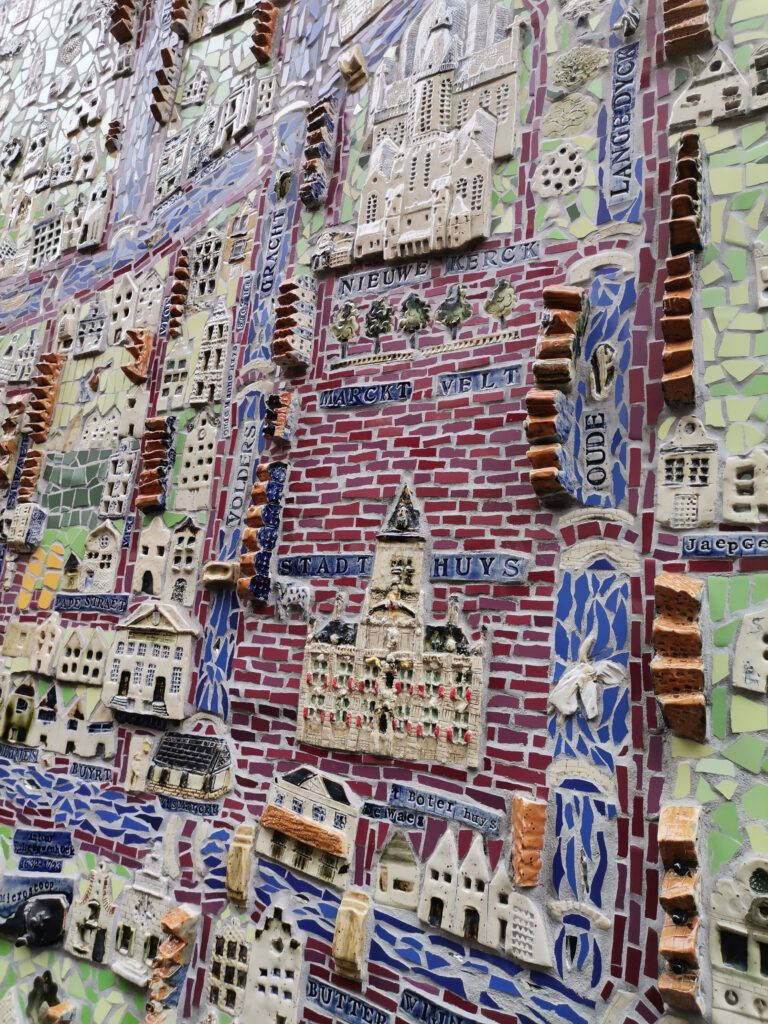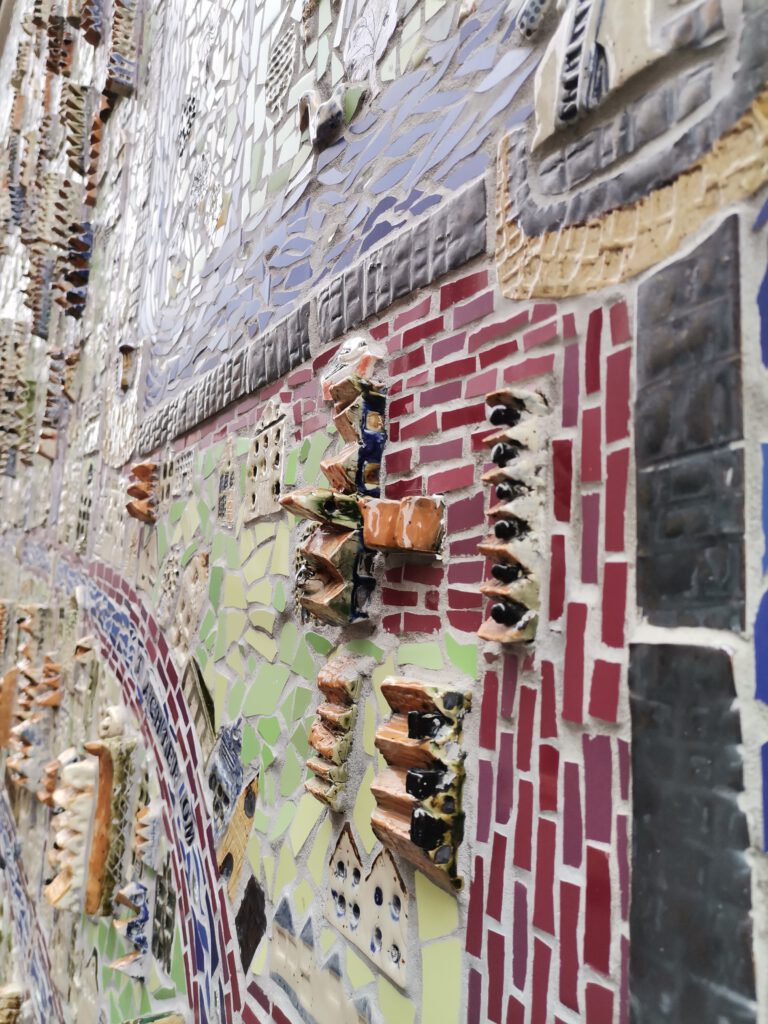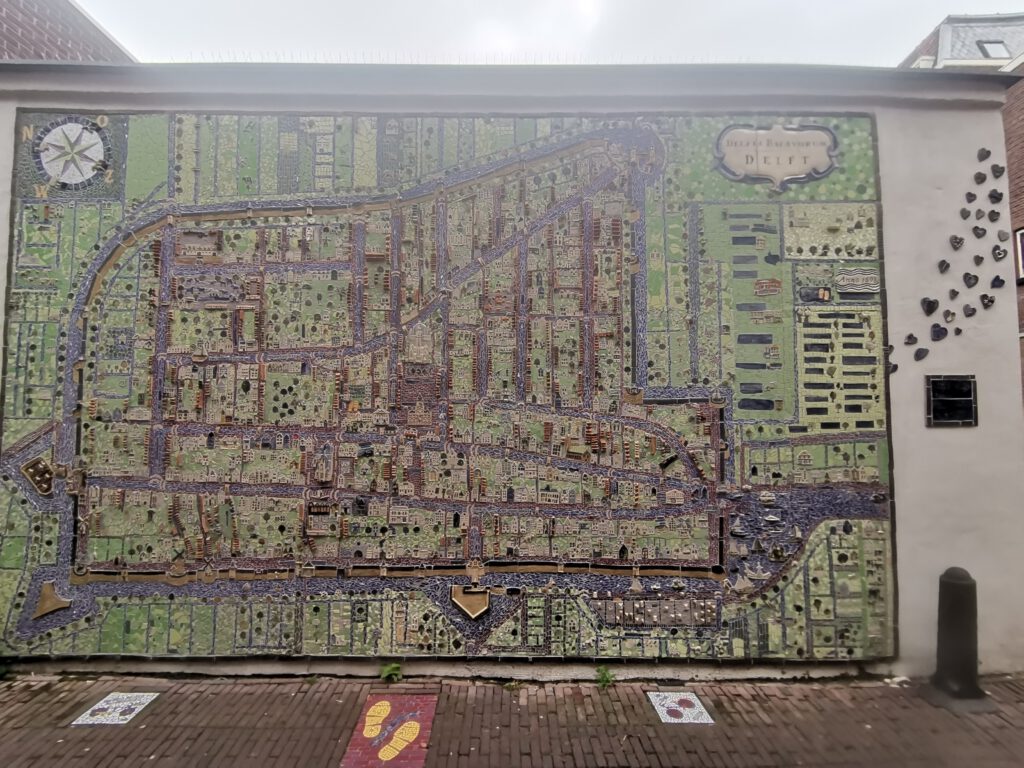When one thinks of street art, graffiti images on walls or random sculptures along walkways most readily come to mind. Rarely does this concept bring to mind mosaics, mini-sculptures or intricate ceramics. The ‘Ceramic Map of Delft’ (‘Keramieken Kaart van Delft’), however, can wholeheartedly be classified as emblematic of urban beautification.
Even more exhilarating than seeking out this artwork (which every Delft visitor should do!) is perhaps stumbling upon it by chance.
A Golden Age map
Crafted by volunteers and skilled artisans, the artwork covers a 18m2 wall on which a map has been made of ceramic houses, trees, bridges, mills, street names and buildings. The mosaic finish and 3D effect are both informative and interactive.
READ MORE | Delft will have the Netherlands first Fully Solar Powered Train Station
Adding to the attraction of this 3-D map is the fact that it was completed during the worldwide pandemic. This observation is yet another testament to the ability of art to inspire awe during uncertainty and turbulence.
Awards and unveilings
The Ceramic Map of Delft was officially and festively unveiled on June 26, 2020, by Delft mayor Marja van Bijsterveld. The map is a replica of one from around 1700 and imitates those by Johan Blaeu and Janssonius (circa 1649). In May 2021, it was announced that the ‘Keramieken Kaart van Delft’ had won the Le Comte Prize 2020 from Delfia Batavorum.

Although formal awards and recognition are justly deserved and recognise the beauty of this project, standing in front of the map stirs up the type of excitement and admiration that reflects the artwork’s magic more than any award could.
A community undertaking
Celebrated as a vibrant mosaic artist who has decorated Delft since 2008, Nan Deardorff-McClain is best known for breathing colour onto ordinary Delft walls. Artist Colja de Roo and Deardorff-McClain are the architects of this mosaic on Papenstraat in Delft.
Although both artists guided the process, the ‘Keramieken Kaart van Delft’ was an ambitious community project undertaken by the people of Delft in various workshops throughout the area. It is fitting that this depiction of Delft’s history was crafted by a community of devoted Delft volunteers.
Accuracy and challenges
Even though the making, firing and glazing of the ceramics, inlay and grouting was a lengthy process, it was made with enthusiasm by Delft’s people. What was possibly most challenging to achieve was that every house, tree and part had to be glued separately according to the street plan and in the right place. The result is a combination of scale effect and recognisability of specific buildings and neighbourhoods.

How the piece was constructed
The steps involved in making the map of Delft included sampling ceramic houses, doing weather resistance tests and glaze tests for the right colour palette. A map prototype was also made by Nan Deardorff McClain and Colja de Roo, which was 1m2.
READ MORE | Scenic Delft: 15 great photos to make you wanna visit (Another Dutchreview Photoreport!)
Besides the physical labour going into this project, Public Relations had to be managed during the COVID-19 lockdowns. Subsidiary applications and financial planning were also undertaken to make this idea a reality. Workshops had to be organised and offered to make clay houses along with the glazing and baking process.
Sponsors and participants
The project’s crowdfunding campaign was successful thanks to independent donors from Delft and beyond, along with aid from The Samen Delft Foundation. These participants’ financial help reflects the wealth of character and community that Delft residents have been known for throughout history.

An interactive artwork
Stories, symbols and clues can be discovered on every small part of the artwork. In addition to creating art that one can look at and explore for hours, the artists also came up with activities to engage people who perhaps have not seen the map up close (or for those who have and just can’t get enough of it!).
Every week, The Facebook Page ‘Keramieken Kaart van Delft’ posts stories and clues about one of the hidden gems on the map.
Have you seen this majestic piece of work? Tell us about your experience in the comments below!
Feature Image: Kathryn van den Berg/Supplied.



